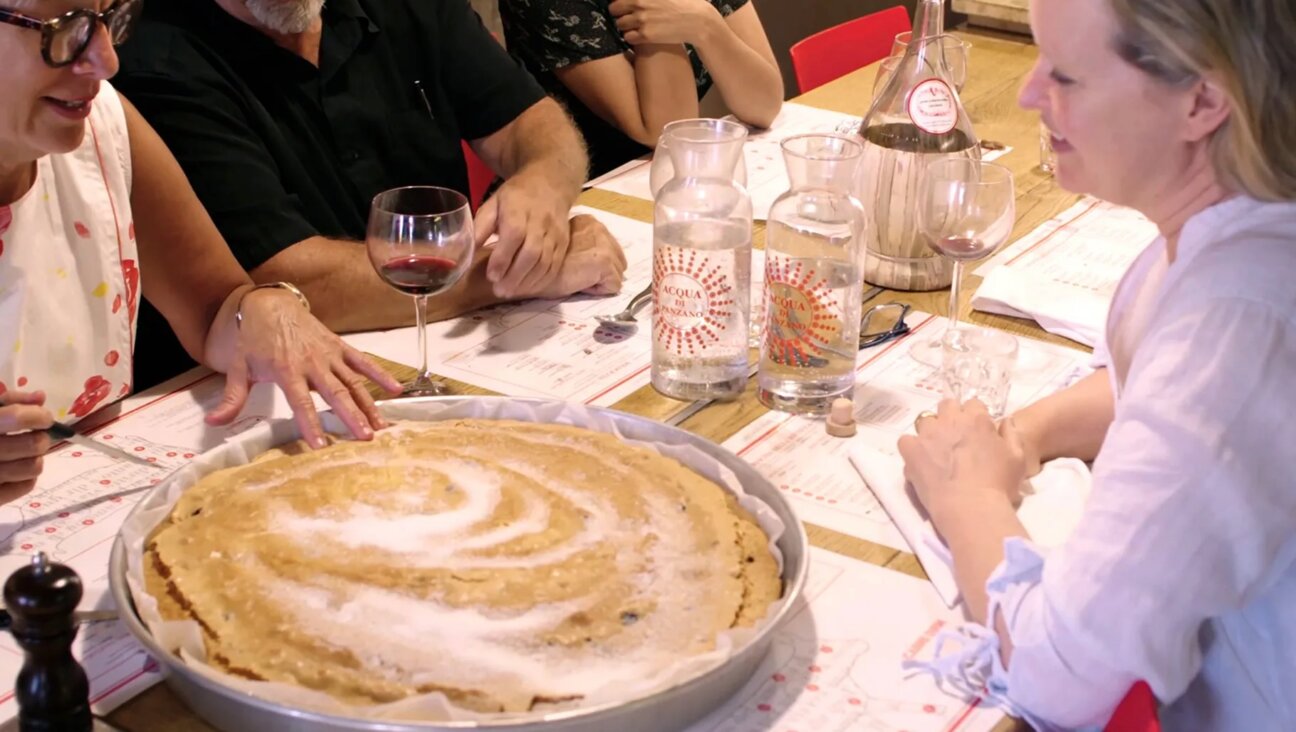Taste Testing: ‘Cook in Israel: Home Cooking Inspiration’ by Orly Ziv

Graphic by Angelie Zaslavsky
“Would You Make This?” is a sporadic column where personal chef Alix Wall evaluates a cookbook by making some of its recipes, sharing them with friends and asking what they think of the results.
When tourists want to learn more about local food in Israel, they often end up in the kitchen at the home of Orly Ziv. A trained nutritionist, Ziv who has been leading culinary tours and teaching classes under the name “Cook in Israel” since 2009. In a typical class, she takes her hungry students shopping in Tel Aviv’s Shuk HaCarmel and to a pita bakery, and then back to her home to make classic dishes like hummus, Moroccan fish and plum cake.
If a trip to Israel isn’t in your near future, getting your hands on a copy of Ziv’s new cookbook “Cook In Israel: Home Cooking Inspiration” with Orly Ziv with photos by Katherine Martinelli, will easily satisfy your cravings.
The book has a healthy bent and most of the recipes are vegetarian with some mouth-watering sounding fish dishes and only two meat dishes (Ziv herself has been a pescaterian for almost 30 years, but, on occasion, cooks meat for her family). Not surprisingly, Israeli favorites like tomatoes and eggplant are the stars of this book as are salads of all kinds — including some more unusual options like a raw beet and apple salad. The book ends with a surprisingly rich dessert selection with recipes for an orange, semolina and coconut cake and chocolate/halva babka.
I took a gathering with some friends as an opportunity to test four recipes from the book. For a Shabbat dinner, we made Fish Kebabs with Yellow Tahini Yogurt Sauce, Swiss Chard with Rice, and Moroccan Carrot Salad. For breakfast the following morning, we made Green Shakshuka. The results were mixed, but good enough for me to endorse buying the book if you love Israeli food.
I was intrigued by the Fish Kebabs, which are basically meatballs made out of fish and fresh herbs (parsley, cilantro and mint), served with a vibrant yellow sauce of tahini and yogurt spiked with turmeric oil on the side. While the recipe said to chop the fish finely, I think a food processor should have been suggested. I chopped the fish small, but evidently, not small enough, as without any binding agent, the kebabs fell apart in the pan, prompting one friend to say the dish reminded her of warm ceviche. While the recipe called for lemon zest, it didn’t say how much, so we found the finished fish needed more acid, though the sauce did greatly enhance it.
The Swiss Chard with Rice was also problematic. In this dish, onions and then chard are sautéed with cilantro and paprika, and then water and rice are added until cooked. We found the proportions to be way off. A half cup of rice for 4 to 6 people? Only ¼ cup water? We also nearly doubled the amount of paprika.
One friend said it reminded her of the Indian saag, in which mustard greens or spinach are also cooked for much longer than we’re used to. With all the modifications we made, I enjoyed it a lot, but one friend said she would have liked it better if the onions and greens were sautéed with the spices for a shorter amount of time, and then mixed into the cooked rice. I could see her point, but longer-cooked greens such as Southern-style collards have their place too. It felt very much like comfort food to me.
Moroccan carrot salad, an Israeli staple, rounded out the meal. In the recipe, sliced carrots are boiled for a few minutes, and then tossed in a dressing of lemon juice, olive oil, cumin, garlic, paprika, parsley and salt and pepper. This is one case in which Orly follows her Greek grandmother’s lead and doesn’t give amounts. We had to use our discretion — and if you’re comfortable in the kitchen, that will be just fine. The salad was even better the day after it was made, when the flavors had more time to develop.
The Green Shakshuka, which we prepared for brunch the next morning redeemed the book. In Ziv’s version, onion, garlic, Swiss chard and spinach are cooked down, to which then heavy cream, white wine and nutmeg are added. Eggs are then nestled into the greens.
While this was a much richer dish than most of us usually eat for breakfast, everyone claimed it melted in their mouths, and took photos of it cooking in the pan. This was the undisputed winner of this book, hands-down.
While my taste-testing yielded uneven results, this book features simpler fare than either Yotam Ottolenghi and Sami Tamimi’s “Jerusalem” or Einat Admony’s “Balaboosta.” “Cook in Israel” is for those who like their Israeli food less fussy and with fewer ingredients.























